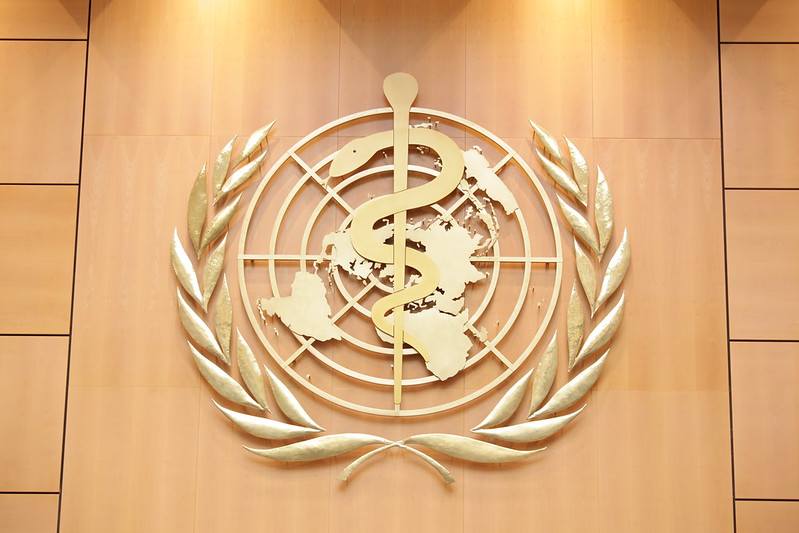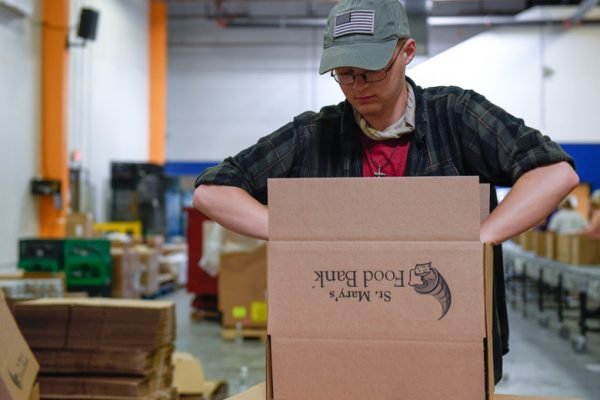On April 14, with 8,300 recorded deaths in the United States from COVID-19, President Trump announced that he was suspending funding to the World Health Organization (WHO). “With the outbreak of the COVID-19 pandemic, we have deep concerns whether America’s generosity has been put to the best use possible,” Trump said during his nightly press briefing. The president called for a sixty-day suspension of aid to the WHO; a resumption would occur on indefinite terms and on an unspecified date, if it all.
Trump’s announcement to pull U.S. funding from the WHO is only the most outlandish and conspicuous outcome of a forty-year effort to marginalize international cooperation on global health.
Trump’s decision is indeed unprecedented. Not once in its over seventy-year history has the United States altogether cut off its funding for the WHO, an organization created under the auspices of maintaining a peaceful and prosperous postwar order following World War II. According to many foreign policy experts, this was another example of Trump’s unique hostility toward the “liberal international order” over which the United States has presided since 1945. “We are basically handing more influence over to Beijing,” said Yanzhong Hang, a senior fellow for global health at the Council on Foreign Relations. House Speaker Nancy Pelosi denounced Trump’s decision as one that is “dangerous, illegal and will be swiftly challenged.”
But in the fallout of his announcement, both Trump and his critics are countenancing the same myth: that U.S. generosity and support for international institutions has enriched the world’s health for decades—until now, until Trump. True, the United States does give large sums to the WHO, and as many have noted, the United States is the WHO’s largest single donor. If Trump’s threats are carried out in the long term, this would greatly strain operations in already desperate times.
But that is the point: the times are indeed already desperate. Since the 1970s Washington has regularly used its budgetary power over international institutions—those designed to promote the ends of global solidarity through multilateral cooperation—to limit agendas, shape operations, and defeat democratic reforms contrary to its interests. Indeed, the United States has often promoted the interests of global capitalism over international development, empowering private actors such as Bill and Melinda Gates (their foundation is the WHO’s second largest contributor) in the Global South. Trump’s decision to defund the WHO must be told in this context: the forty-year bipartisan campaign to privatize efforts to solve global health problems, and the U.S. abdication of social and economic rights for the world’s population in favor of neoliberal reforms.
The founding of the WHO in 1948 was a high point—perhaps the defining moment—for U.S. liberal internationalism. The 1947 Truman Doctrine provided the guns for Western Europe’s defense, but it was the 1948 Marshall Plan that brought the butter for healthy growth. The nearly $13 billion package (about $140 billion today) helped get Western Europe back on its feet (and keep it away from communist subversion), the story goes, enabling three decades of tremendous postwar prosperity for the U.S. and its European allies—the so called “Golden Age” (or Les Trentes Glorieuses) of Western capitalism. Secretary of State George Marshall put it bluntly when he announced the European Aid Program to Harvard’s class of 1947: “It is logical that the United States should do whatever it is able to do to assist in the return of normal economic health in the world, without which there can be no political stability and no assured peace.”
Any attempt to revive solidarity between rich and poor nations must begin by recapturing the commitment to social and economic rights on which the WHO was founded.
The Marshall Plan also provided a convenient outlet for the massive trade and financial surplus the U.S. faced after the war, necessary for it to avoid a return to recession. But behind Marshall’s logic was an early postwar consensus around basic economic and social rights, as a matter of justice, but also order. When Allied diplomats met in San Francisco in 1945 to discuss the new United Nations, one of the first things they planned was the creation of a World Health Organization. At the International Health Conference in July 1946, the sixty-one member states hammered out a constitution, which would come into force two years later with U.S. approval and support. The WHO’s founding preamble not only declared universal health care “one of the fundamental rights of every human being without distinction of race, religion, political belief, or economic and social condition.” It also identified “unequal development in different countries in the promotion of health” as a “common danger” to world peace. This made the WHO perhaps the first UN institution focused specifically on development in the Global South.
By the late 1950s, issues of global health—and attention to the WHO—were viewed within the context of the U.S.-Soviet competition and the need to have resilient, anti-communist partners in the Global South. The WHO represented a multilateral, yet seemingly nonpartisan organization that could serve as a vehicle for a U.S. victory in the Cold War, a testament to capitalist progress. To the many liberals and Democrats who backed it, the WHO exhibited unrelenting faith in technocratic solutions—teleological faith in human progress, and the assurance of better living through science.
U.S. investment in the WHO during the first twenty years of its existence thus aimed to fulfill the broader purposes of U.S. hegemony during the Cold War, to align the commitment of U.S. power to the cause of public health. Leading liberal Cold Warriors such as Democratic Senator Hubert Humphrey, for instance, envisioned a Pax Americana for global health issues. Humphrey traveled to Geneva in 1958 to ascertain the status of word health concerns—and highlight the advancements the WHO had made on health (including infectious diseases). The “WHO has become the hub of the world health wheel, the center of motion for innumerable constructive forces,” Humphrey said upon returning to the United States. The WHO owed its illustrious position almost exclusively to U.S. investment in public health. Humphrey felt that “as a nation, itself, no people have contributed more generously to health through private and public means, unilaterally, bilaterally, and multilaterally than have the American people.”
As money from the United States and other rich countries declined, organizations like the WHO turned to the private sector to fill the gap.
By the mid-1960s, President Lyndon Johnson viewed the WHO as an institution that could advance his Great Society in global terms, one that could end poverty and disease throughout the world. But as a liberal internationalist who saw international institutions as necessary for marshalling consensus behind U.S. foreign policy, Johnson knew he had to rely upon the WHO to legitimize his global Great Society. His efforts to eradicate smallpox in the 1960s, for instance, relied on the WHO as a mediating force to carry out a Smallpox Eradication Program (SEP) in the Global South, helping to negotiate the health interests of non-aligned states in Africa and Latin America with the Soviets’ and Americans’ bilateral struggle for control of global development. As historian Erez Manela has argued, the WHO served “as an institutional space in which this parallel discourse of cooperation could operate” while also being “a politically neutral receptacle for the SEP’s successes.” In 1965 Johnson predicted an end to smallpox worldwide by 1974, but only “if greater resources are made available for an intensified attack upon it,” and the United States remained committed to “international cooperation to keep people from dying.”
Within a few years, the U.S. economy would come screeching to a halt—and with it, hopes for more U.S. leadership and resources for international public health efforts. President Nixon’s 1971 New Economic Policy unilaterally ended the Bretton Woods gold-exchange standard and imposed a 10 percent tariff on imports, devaluing dollar-based assets worldwide. In October 1973 Arab members of the Organization of Petroleum Countries (OPEC) introduced a boycott that quadrupled the price of oil (based in U.S. dollars) within a matter of months.
But recession and an energy crisis are not the only reasons the U.S. turned away from support for UN development efforts during this time. Decolonization in the 1950s and ’60s had transformed the dynamics of power in the UN General Assembly, where the one-country, one-vote principle allowed the new “Group of 77” caucus of developing countries to press for more ambitious reforms to global trade and aid. On May 1, 1974—International Labor Day—Algeria’s firebrand president and OPEC leader Houari Boumédiène introduced to the United Nations the G-77’s program for a New International Economic Order (NIEO) “based on equity [and] sovereign equality” and designed to “correct [past] inequalities and redress existing injustices.”
Like almost every other UN body, the WHO endorsed the NIEO. From the perspective of Dr. Halfdan T. Mahler, the WHO’s Danish director-general (1973–88) who led the organization’s fight against tuberculosis in the 1950s and ’60s, the NIEO declaration was completely in line with the WHO’s expansive understanding of inequality. In his address to the World Health Assembly on May 15, 1975, Mahler spoke of the “changes that are rapidly taking place in the political and economic relationships between Member States.” Like other UN officials, he exhibited great public faith in the NIEO’s possibility: “1974 will be remembered by many of us, and possibly by future historians, as a turning point in our thinking about the future social and economic development of mankind.”
The creation of the NIEO put U.S. liberal internationalists on the defensive. According to the Trilateral Commission, the events of 1974 “denotated an explosion in North-South relations that had been building up for years” and “raised the most troubling questions” about the U.S.-led postwar world order. For another group of Americans, however, more troubling was liberal internationalists’ unwillingness to denounce what they saw as a hostile takeover of the UN by illiberal Third World forces. In March 1975 Daniel Patrick Moynihan called for the United States to “go into opposition” at the UN to defend the country’s international reputation (“find its equal”) and reclaim U.S. control over UN institutions. He soon had his chance as President Gerald Ford’s Ambassador to the UN. “Moynihan has enraged Third World delegates, discomfited his Western European colleagues, and brought cheer to the hearts of Americans,” Time magazine rhapsodized in a flattering January 1976 profile on the “fighting Irishman” at the UN.
By Ronald Reagan’s first year the NIEO was no longer a serious threat, but U.S. hostility toward the UN was about to reach new heights. The 1983 Kemp-Moynihan amendment to the UN appropriations bill withheld funds to any UN program that supported the Palestine Liberation Organization. In 1985 the United States withdrew from UNESCO, charging that it had become too “politicized.” During that year the Reagan administration also began a long pattern of not paying its UN dues, forcing budget cuts and layoffs in several organizations. Typical during this time was the Reagan administration’s sole opposition to a WHO agreement regulating infant formula marketing in poor countries, on the grounds that it would set a “dangerous precedent” for “free enterprise versus government regulation” and cause “first amendment issues” for multinational corporations.
The end of the Cold War left the WHO disempowered, floundering for attention from the most powerful nation-states and now mobilizing against the COVID-19 pandemic under countervailing conditions of global austerity.
As money from the United States and other rich countries declined, organizations like the WHO turned to the private sector to fill the gap. Since the 1990s organizations from the World Bank to the WHO have embraced Public-Private Partnerships (PPPs) to carry out projects around the globe. This is the model followed by Gates and Clinton foundations, one where the health of nations—in both physical and economic terms—is based on a public-private conception of rights in which citizens must compete for influence with corporations.
PPPs can do a lot of good, but their results-oriented approach comes at a cost. Not only do they further discourage rich governments from giving more, but their donations come with specific earmarks that must be spent on high-profile communicable diseases and shared with their private sector “partners,” including pharmaceutical companies that aggressively trademark patents responsible for high drug costs in rich and poor countries alike. And while the U.S. remains (for now) the largest donor to global health efforts, only 20 percent goes to multilateral organizations like the WHO. Half of the budget is earmarked for AIDS, and 10 percent for malaria, but nothing for the less-glamorous yet equally important (and interdependent) task of building greater health care infrastructure and self-sustainability in poor countries.
Any attempt to revive solidarity between rich and poor nations—after the decades-long effort to make the private market the progenitor of public goods—must begin by recapturing the commitment to social and economic rights on which the WHO was founded. The end of the Cold War left the WHO disempowered, floundering for attention from the most powerful nation-states and now mobilizing against the COVID-19 pandemic under countervailing conditions of global austerity—ones that have produced a poverty of U.S. support for WHO. Decades of working to make the functions of the WHO ancillary (or complimentary) to private delivery of public health resources, as a vestigial appendage of U.S. global dominance, have given Trump the excuse he needs to altogether eliminate the WHO as a vital organization. Seen in this long view, Trump’s announcement to pull U.S. funding from the WHO is only the most outlandish and conspicuous outcome of a forty-year effort to marginalize international cooperation on global health.








